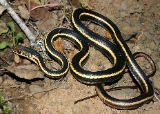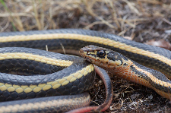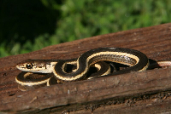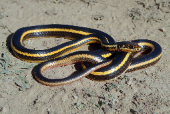Alameda Whipsnake (Masticophis lateralis euryxanthus)
Description: Adults reach a length of 3 to 4 feet. Their back is colored sooty black or dark brown with a distinct yellow-orange stripe down each side. The front part of the Alameda whipsnake's underside is orange-rufous colored; however, the midsection is cream colored, and the rear section and tail are pinkish. The Alameda whipsnake is a slender, fast-moving, diurnal snake with a broad head, large eyes, and slender neck.
Habitat: Open areas in canyons, rocky hillsides, chaparral scrublands, open woodlands, pond edges, stream courses.
Range: The whipsnake once had a continuous range in the inner Coast Ranges in western and central Contra Costa and Alameda counties (California) which is now fragmented into five populations.
Found in these States:
CA
Diet: The Alameda whipsnake is a diurnal ectotherm that is often seen foraging in the daytime. As it searches for food, the head and the front half of the body are held off of the ground for the most optimal vision to find prey. The snake has two seasonal peaks in activity, one during the spring mating season and the other during late summer or early fall. In the spring, males tend to forage and search for mates while females stay in hibernation. Female peak activity only tends to be a few days in the spring when they are looking for egg laying sites. When the Alameda striped racer finds prey, such as the Western fence lizard (Sceloporus occidentalis) or the Western skink (Eumeces skiltonianus), it takes the prey quickly, holds it tight under the loops of its body, and swallows it whole without constriction. Alameda whipsnakes are great climbers and are able to quickly move through trees and shrubs to hunt prey or escape predators
Reproduction: Courtship and mating are observed from late March through mid-June. During this time, males move around throughout their home ranges, but females appear to remain at or near their hibernacula, where mating occurs. Female egg laying sites are typically located in grasslands with scattered shrub habitat. Copulation commences soon after emergence from winter hibernacula. Females begin laying eggs in mid-late May. Average clutch size is just greater than 7 eggs with a significant correlation between body size and clutch size. Once the female lays her eggs, it will be about 3 months of incubation before the young appear in the late summer and into the fall .
Status: Listed as Imperiled or Threatened. Small range in hills in the eastern San Francisco Bay area, California; declining due to loss of habitat to commercial and residential development and degradation of habitat as a result of overgrazing by cattle and altered fire regime.
»» Kingdom: Animalia - Animals
»» Phylum: Chordata - Chordates
»» Subphylum: Vertebrata - Vertebrates
»» Class: Reptilia - Reptiles
»» Order: Squamata - Scaled Reptiles
»» Suborder: Serpentes
»» Superfamily: Colubroidea
»» Family: Colubridae - Colubrids
»» Genus: Masticophis
»» Species: Masticophis lateralis - Striped Racer
»» Subspecies: Masticophis lateralis euryxanthus Alameda Whipsnake
This article uses material from the Wikipedia article "Alameda Whipsnake", which is released under the Creative Commons Attribution-Share-Alike License 3.0. Content may have been omitted from the original, but no content has been changed or extended.
|













